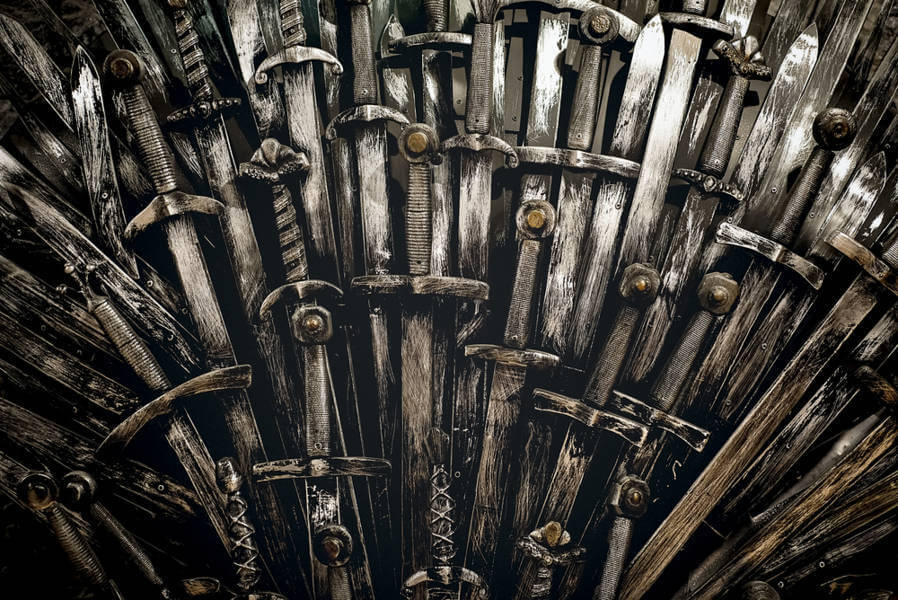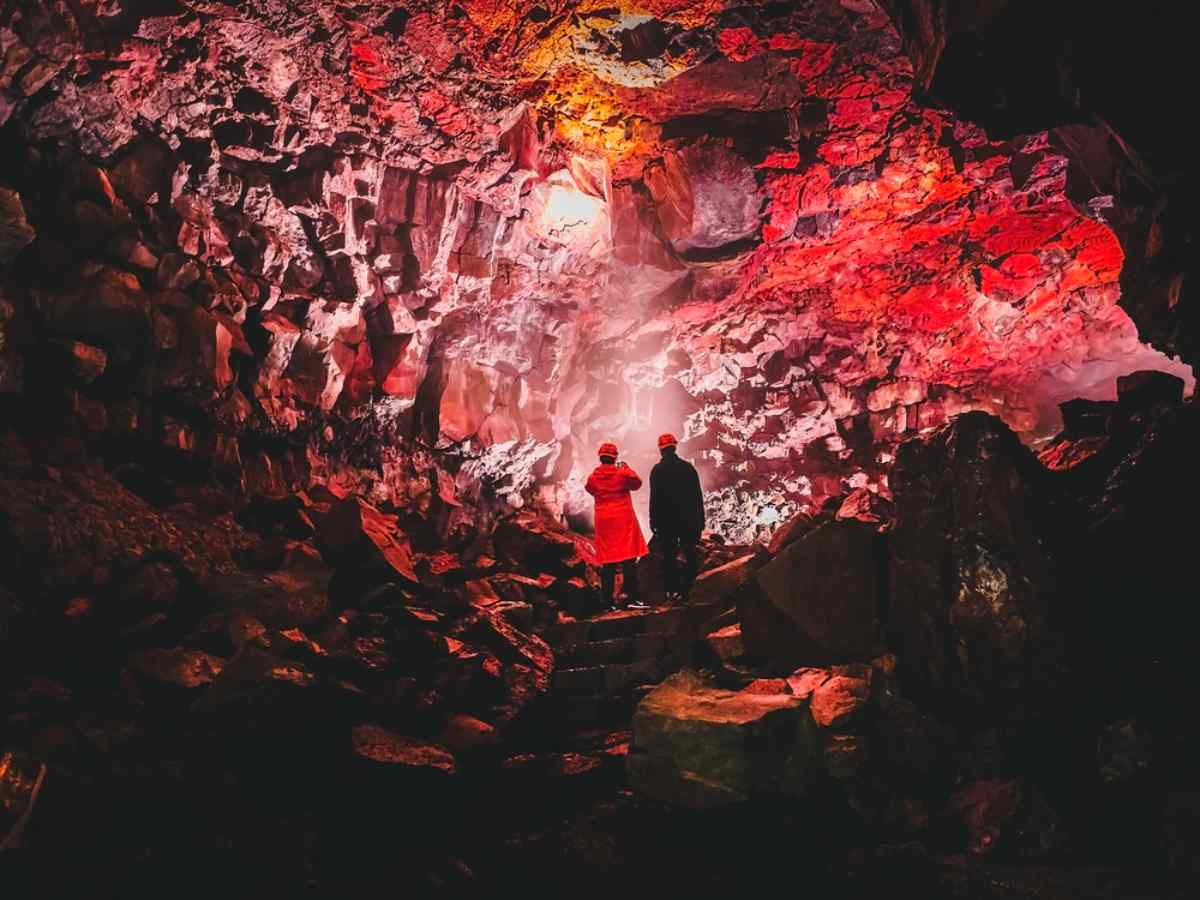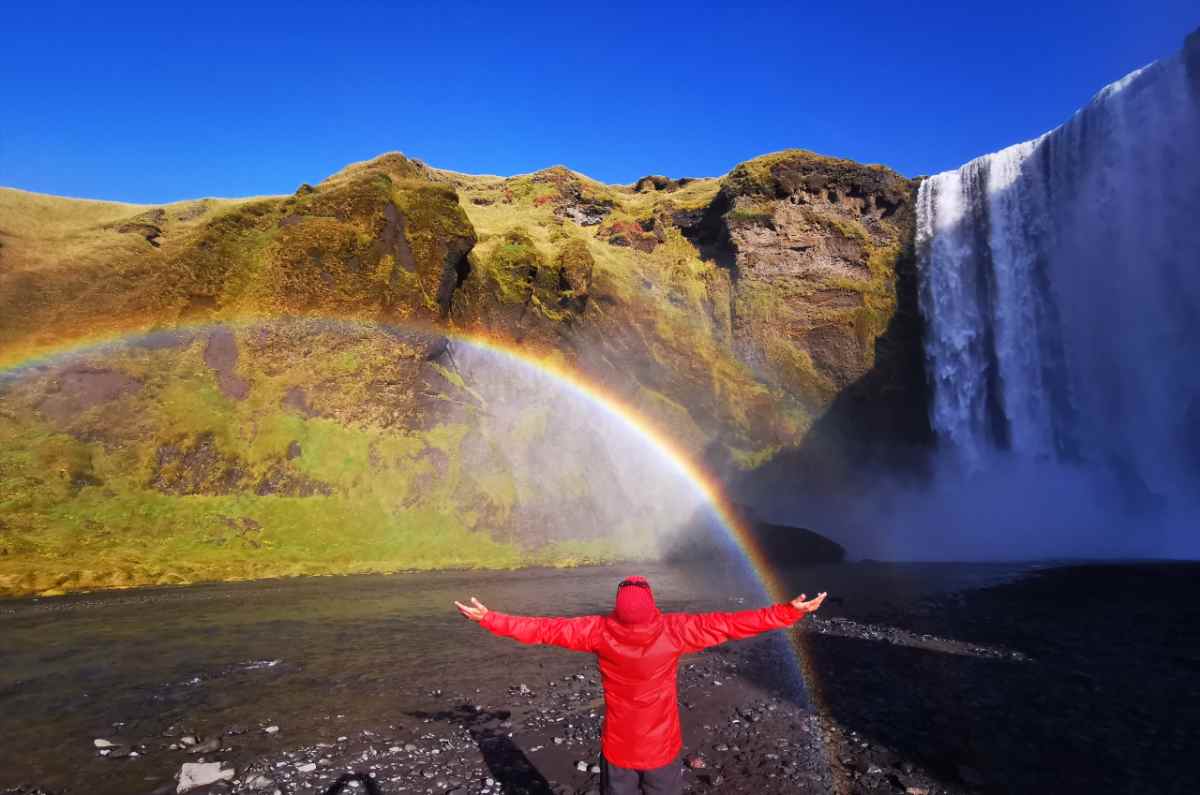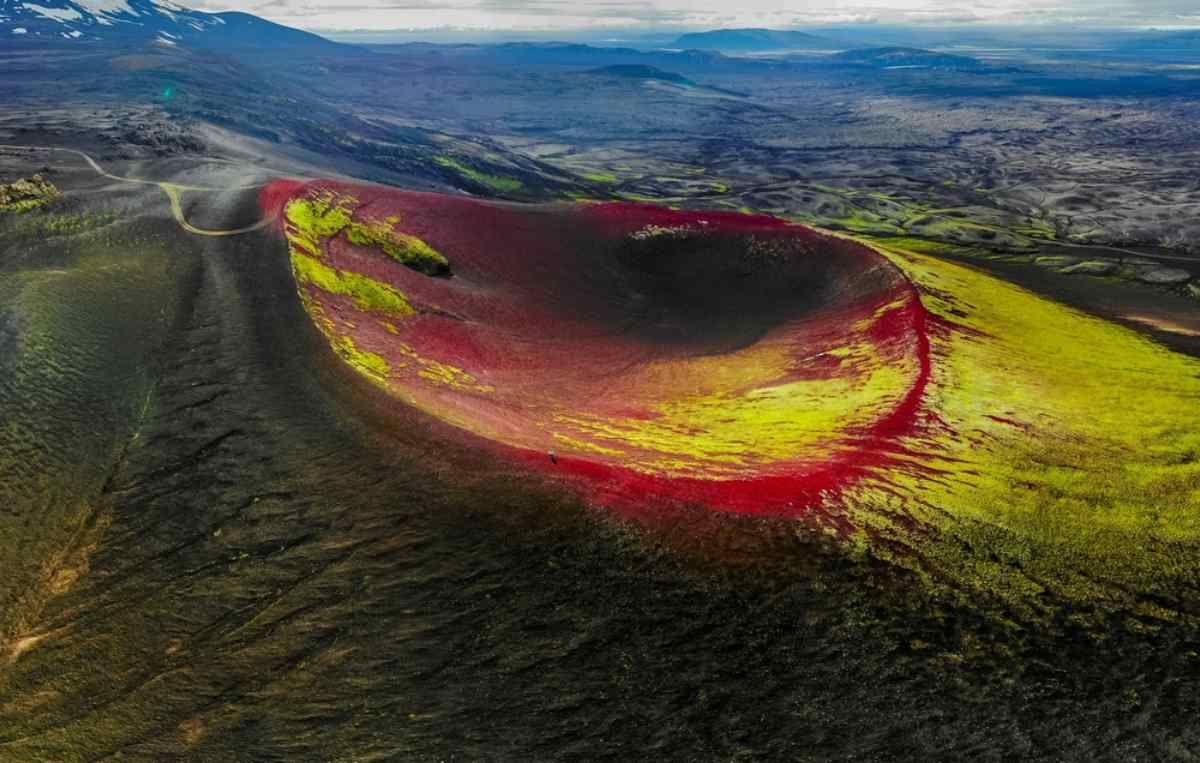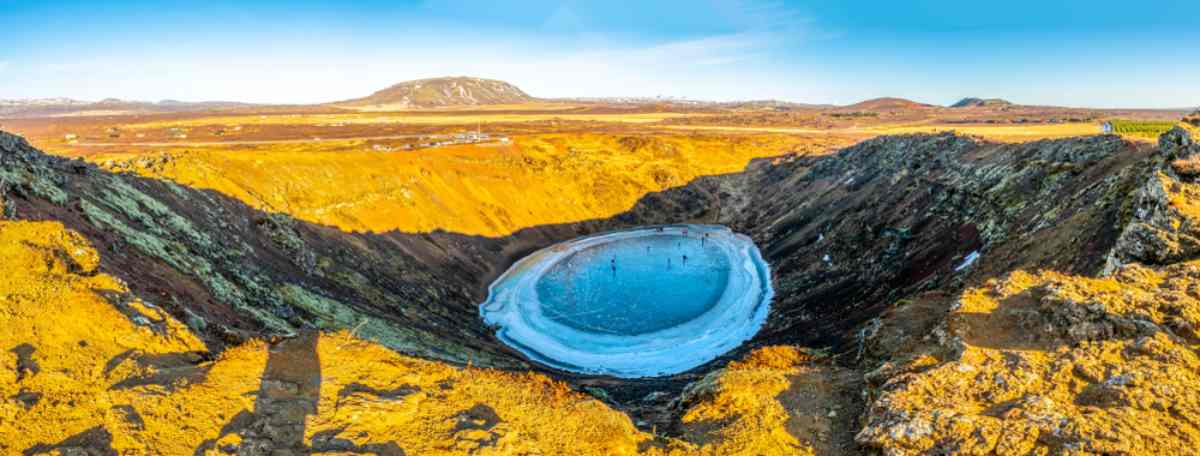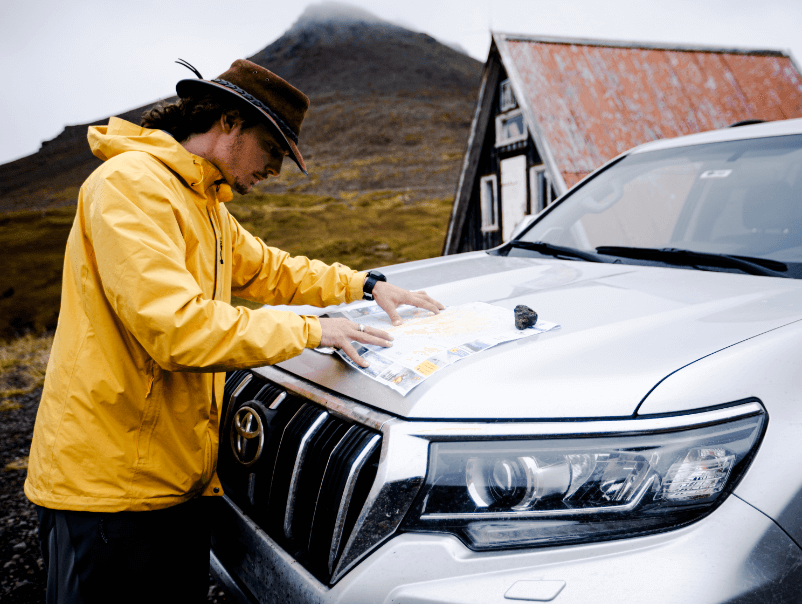Iceland is known for its legendary black sand beaches. They tell the tale of thousands of years of elemental clashes here in the Land of Fire and Ice. And while Djúpalónssandur is another of these black sand beauties, there’s much more to this extraordinary place.
If you have an upcoming trip to the island planned, or you’re pondering which places are worth visiting here in Iceland, Djúpalónssandur should definitely make it onto any Iceland trip itinerary. This article will serve as your ultimate guide to Djúpalónssandur and its surroundings so you can know exactly what to expect and how to prep for your visit.
A Brief Overview of Djúpalónssandur
As we already mentioned, Djúpalónssandur is a black sand beach and one of two bordering an incredibly picturesque bay called Dritvik Cove. This breathtaking scene is also found in one of the most beautiful regions in Iceland, the Snæfellsnes Peninsula. Djúpalónssandur is famous for its geology and rich history, and you can expect plenty of stories interconnected in this lava wonderland with all its interesting rock formations.

Location and Accessibility: Getting to Djúpalónssandur in Iceland
As we already mentioned, Djúpalónssandur is in one of Iceland’s regions, famous for its breathtaking landscapes: Snæfellsnes Peninsula. The beach and bay can be found at the foot of this incredible Peninsula in the Snæfellsjökull National Park in western Iceland.
It is roughly 180 kilometers away from the capital city of Reykjavik, making it possible as a day outing during the warmer months when you have plenty of daylight hours. Still, we prefer adding it to our road trip itinerary. Visiting Djúpalónssandur can essentially be done in one of two ways: either via a tour or a self-drive. Tours are conducted around the island every day by local tour operators and guides.
These tours can range from day tours to multi-day holiday packages. If you can’t find a tour with Djúpalónssandur as a destination that takes your fancy, you can always inquire about a customized private tour. We, on the other hand, will always vote for traveling and exploring the island ourselves. Not only is this the best way to immerse yourself in your surroundings, but it also ensures that you stay in charge of your itinerary and time.
The trip to Djúpalónssandur will take you roughly 3 hours from the capital city and is a pretty easy drive. The road one must take is also called the Snæfellsnes Peninsula Road and is known as a scenic road trip route. So, get onto the Snæfellsnes Peninsula Road (aka Route 54), cross the Utnesvegur Road, and then turn south onto Dritvikkurvegur Road. You will soon see the Djúpalónssandur parking lot.

The Historical Background of Djúpalónssandur
There’s quite a lot of history contained in this small cove, and knowing its past may give you a renewed appreciation for it in the present. Let’s journey back in time to discover Djúpalónssandur’s roots.
Djúpalónssandur’s Early History and Fishing Village
The Dritvik Cove made for the perfect natural harbor. So, although it might be hard to imagine today when looking at this unpopulated area, Djúpalónssandur was once a flourishing fishing community in the 16th to mid-19th centuries. During these years, it was not strange to see at least 50 rowing boats manned by 200 to 600 fishermen heading out to see daily, especially between April and mid-May when it would be prime fishing conditions.
If you look out to sea, you will see two protruding rocks, Brjotur and Bardarskip, which essentially marked the “gate” into the bay. And if you visit the lava fields near the black sand beaches of Dritvik today, you will also be able to see the remnants of enclosures built where they could dry the fish for the market. Then, there are also a few leftover elements from the good old fishing years that visitors can have a lot of fun with today.
When walking the beach, you will come across Aflraunasteinar, or what others refer to as lifting stones. These four Dritvik stones range in size and weight and were used to test fishermen’s strength. This would ultimately be the test to see if they could earn a spot on one of the fishing boats heading out to sea.

Although there are no longer any fishermen standing in line and taking on the challenge to see if they’ve got what it takes, many a visitor is now giving it a go. The four stones are divided into the following:
- Stone 1, called Amlodi. Amlodi weighs 23 kilograms, and you should probably not feel too proud if you’re able to lift up this stone (Amlodi means “useless”).
- Stone 2, called Halfdrættingur. Halfdrættingur weighs 54 kilograms, and lifting this one will still not mean you’re up to scratch as the name means “weakling.”
- Stone 3, called Halfsterkur. Halfsterker weighs 100 kilograms, and if you can lift this one, you’re in the running for being considered a part of the crew. Halfsterker means “half-strong”).
- Stone 4, called Fullsterker. Fullsterker weighs 154 kilograms, and if you can lift this puppy, you’re a wanted fisherman for sure. Fullsterker means “full-strong.”
The Epine Shipwreck
If you stroll along Djupalonssandur Beach, you will probably come across strange orange-colored iron pieces. These are all that’s left of the Epine GY7, a British trawler that went under here in Dritvik Cove on 13 March 1948. This was quite a heartbreaking disaster. A total of 14 fishermen lost their lives that night, with only three bodies actually washing up on shore. The rest was lost at sea.
Only 5 men survived the ordeal, and rescue efforts were also hampered by what was probably the culprit causing the wreck in the first place: a terrible blizzard. Rescue teams came from the neighboring villages to help, and it took over 2 hours before they managed to get a rescue line to the trawler. Many of the men actually managed to get a hold of the line, but the bad weather caused most to lose their grip and disappear beneath the water.
Alfred Loftis, the skipper, was last seen clinging to the ship and desperately yelling to the rescue teams: “I do not mind what happens to me as long as the boys are all right. Look after the boys!” Moments later, he was swept away by a massive wave. Today, the pieces of iron on the beach are not because cleaning crews could not be bothered cleaning it up but because they serve as a memorial to all the men who lost their lives that night.
This also means that visitors should not be messing about with what’s left of the wreckage and definitely not try to take pieces with them (you can visit one of our many souvenir shops on the island if you want a keepsake of your trip).

The Folklore and Legends of Dritvik and Djupalonssandur
You will find plenty of myths and legends at Dritvik and Djupalonssandur. These are just a few:
The Curse of Djupalonssandur
Djupalonssandur is also called the “Black Lava Pearl Beach,” a reference to the small black pebbles lining the shore. These pebbles are actually protected, and called Djupalonsperlur, which translates to “Pearls of Djupalon”. Legend goes that if you were to take some of these pebbles, that great misfortune would come your way.
The Church of the Elves
There is a large, reddish lava rock that can be found on the beach at Djupalonssandur. This rock is named Söngklettur Rock, which translates to “Singing Rock,” but it’s generally known as the Church of the Elves. So, be careful how you approach this rock. Any messing about and disrespect will result in you feeling these supernatural creatures’ wrath.
Kerling (the Troll Woman)
There is a basalt rock formation at Djupalonssandur that juts out of the ocean near the shore. It is said that this once was Kerling (a troll woman) who was on her way out of the sea, carrying a bunch of fish, when she lost track of time and was caught in the sunlight.
Whenever a troll gets caught in sunlight, they are turned to stone, just like this Kerling that’s a Djupalonssandur Sea Stack today. You will find many of these types of Kerling (troll women) and Karl (troll men) who got turned to stone around the island.
Murder and Revenge at Djupalonssandur
There is a story that can be found in the Collection of Folklore by Jon Arnason that might leave you ice-cold. It tells the tale of the fishermen of Djupalonssandur who, depending on which version of the story you hear, either murdered an old woman or dug her up from her fresh grave.
Either way, the story only goes downhill from there, as they use the woman’s body as bait during fishing expeditions. Their morbid tactics worked, and they caught boats full of fish while the other fishermen merely stared longingly at their haul. But one man onboard named Sigurdur refused to partake in this macabre activity.
One night, he dreamt of the old woman, and she spoke to him in a rhyme: “Verdur a morgun skip skarda, skedur furdu tilburdur; Fardu ei a morgun forvarda, furda ber til, Sigurdur.” In another version of the story, she also added: “Ei skaltu i dag roa; nu ætla eg rugla undir beinum minum.” Without translating everything directly, the gist of her speech is that Sigurdur should not accompany his fellow fishermen out on their fishing expedition the next day, since something will happen.
Sigurdur heeded the old woman’s warning and acted as if he was sick to avoid going out to sea. The rest of his team went, and although it doesn’t say precisely what happened, all of them drowned. The old woman got her day of revenge.

The Origins of the Name Dritvik
According to legend, the name Drivik means “Dirty Bay,” and the cove got its name from a time when local sailors washed their clothes in the bay. It became so muddy that it became completely unusable, leaving the fishermen empty-handed.
Geological and Natural Features
Humans and supernatural beings aside, there’s plenty to experience here at Djupalonssandur. This is just some of what you can look forward to:
Black Sand Beaches and Lava Formations
Djupalonssandur is testimony of Iceland’s fiery side as the Land of Fire and Ice. The black sand and pebbles, along with the strange basalt rock formations, are all the result of past eruptions.
Basalt is nothing more than hardened lava, and the pebbles and sand found on the beaches today are lava that flowed across the landscape, cooled down to form a hardened sheet of sediment, and was then broken down into tiny pieces and shaped to what it is today by time, the weather, and the crashing waves.
When it comes to some of Djupalonssandur’s most famous lava formations, we’ve already discussed two (Söngklettur and Kerling) in our section about myths and legends. The one that we still have to dive into is Gatklettur. Gatklettur is a gigantic basalt rock with a hole in the middle that almost acts as a natural frame for the Snæfellsjökull Glacier, clearly visible in the hole. The glacier, with its rocky border, makes for quite a pretty picture.

The Flora and Fauna of Djupalonssandur
Although you will find some green vegetation, algae, and moss in and around the cliffs of the cove, this region, so severely touched by volcanic activity, isn’t particularly known for its plant life.
That being said, the coastal cliffs are one of the go-to spots for avid birdwatchers, and you can expect to see birds such as Guillemot and Puffins (but the latter can only be seen during their breeding season from April to September). You may also get the chance to spot some of our bigger wildlife in Djupalonssandur and its surroundings. These animals include Reindeer, Icelandic Horses, and the cutest predator you’ve ever seen; the Arctic Fox.
While on the beach, you may also catch a glimpse of some of our marine wildlife, such as whales or seals, although you’ll only get to see the whales from afar. To get closer to these gentle giants of the ocean and our seals, we recommend that you book a boat tour in Reykjavik.
Hiking and Walking Trails at Djupalonssandur
With such beautiful scenery, it would be a missed opportunity not to have hiking and walking trails in and around the area. You also don’t need to be a pro hiker with elite athlete fitness levels to enjoy hiking here. There are numerous trails that vary in distance and difficulty level, so it truly is an activity that everyone can enjoy. If you would like to take a hike or a walk at Djupalonssandur, the following trails are very popular:
Path to the Beach – Djupalonssandur from Olafsvik
Distance: 2.7 kilometers
Duration: +/- 45 minutes
Difficulty Level: Easy
This family-friendly out-and-back trail to the beach starts at the parking lot and takes you past the shipwreck to explore the beach and the bay. Expect breathtaking coastal views along the way.

The Epine Shipwreck – Djupalonssandur from Olafsvik
Distance: 12.1 kilometers
Duration: +/- 3 hours, 10 minutes
Difficulty Level: Moderate
You will need some level of fitness to take on this moderately difficult back-and-forth trail. This trail offers amazing views of Snæfellsjokull Glacier, a pond, the shipwreck, the beach, meadows, and basalt cliffs. So, while this route may be longer and a bit more challenging, it’s definitely rewarding.
Path to the Beach – Djupalonssandur from Hellissandur
Distance: 8.4 kilometers
Duration: +/- 2 hours, 15 minutes
Difficulty Level: Moderate
This is another trail that will require you to be moderately fit. This loop trail starts at the Sandholar Parking Lot and takes you all the way to the beach and the bay while passing the infamous shipwreck.
Djupalonssandur - Dritvik – Aflraunasteinar
Distance: 3.4 kilometers
Duration: +/- 50 minutes
Difficulty Level: Moderate
This loop trail leads down to the beach, taking you past the lagoons and the Gatklettur rock formation. Try your hand at the Aflraunasteinar, aka lifting stones, before looping away from the beach.

Photography at Djupalonssandur
Incredible views and all sorts of interesting rock formations make for the picture-perfect outing (literally). Whether amateurs or pros, many photographers flock to the site to take advantage of the incredible locations at and around Djupalonssandur. While some DIY their photography sessions here, others opt to go on a guided photography tour of Djupalonssandur with an expert who can give you a helping hand and provide you with some valuable photography insights.
Practical Information for Visitors
Below, you’ll find all the information you’ll need to plan a safe and memorable visit to Djupalonssandur.
When is the Best Time to Visit Djupalonssandur?
Djupalonssandur can be visited all year round, but as an outdoor site, the warmer months of the year are obvious favorites. And while the summer months (June to August) may give you the highest temperatures and the most daylight, it is our peak season. So, those who wish to avoid peak season crowds and peak season prices but still want some summer perks usually pick one of the shoulder months (April/May or September/October) for their travels.
Those visiting during the colder months of the year, especially when it’s winter in Iceland (December to March), need to come prepared for some tricky road conditions with snow and ice. You’ll need to make checking the Icelandic weather forecast before heading out a habit.
How Much Does Dritvik and Djupalonssandur Tickets Cost?
Firstly, there are no tickets required to visit Dritvik and Djupalonssandur. You can visit these natural gems anytime you like, completely free of charge. This will, of course, change if you plan on visiting via a guided tour. Then the tour operator or guide will provide you with their prices.
Safety Tips and Precautions When Visiting Djupalonssandur
If this is your first trip to Djupalonssandur, the following tips and advice will be very helpful:
- Please do not remove any of the stones or pebbles on the beach (for the sake of the environment and the historical and geological relevance of the site, and not just because of the curse).
- Please keep to designated walkways and trails, and don’t start creating your own. This is for your own safety but also the protection of our sensitive environment. For example, we have moss here that, when damaged, can take up to a decade to repair, if at all.
- We Icelanders take great pride in our environment, so we show a lot of care and respect whenever we’re out and about. Please ensure you only leave your footprints behind when visiting sites such as Djupalonssandur. Either throw your trash into nearby bins or take it with you until you can properly dispose of it.
- In Iceland, we have a saying that goes: “You can experience all four seasons in a day here”. This is especially important to take note of when visiting outdoor sites or taking part in outdoor activities. Always ensure that you are wearing layers. This way, you can change along with the weather by taking things off when it gets hotter and putting things on when it gets colder. Also, keep a raincoat close by.
- Do not attempt going swimming at Djupalonssandur. This beach is strictly to be admired. Not only is the water likely much colder than you expect, but even when it appears to be pretty calm on the surface, it has really strong currents underneath.
- Save our emergency number somewhere. This way, if anything should happen, help is just a quick dial away. The number is 112 and goes for any/all emergency assistance, from roadside assistance and medical emergencies to fire fighting.

Other Things to Do Near Djupalonssandur
Dritvik Cove and Djupalonssandur Beach aren’t just beautiful places you can gawk at. There are many other interesting attractions and exciting activities to see and do around here. So, if you’re looking to add a few items to your trip itinerary, the following come highly recommended:
Budakirkja
Budakirkja is also known by many other names here on the island, such as Budir Church or the Black Church. All are spot on as this little wooden black church can be found in Budir. This church truly looks like something out of a movie. The church was rebuilt in the 19th century on the spot of an old Turf Church established in 1705 and is a lone building standing in the middle of a lava field.
This would be the perfect location for a movie because you sometimes have the church standing in what appears to be fields of green with the sun baking down on it against a clear blue sky, making it seem almost fairy-tale-like. But on cloudy and misty days, there is a bit of a mysterious and ominous vibe to it. This is probably also why it’s such a much-loved spot amongst photographers – you can get 100 photos from different angles and invoke completely different feelings from just this one location.

Skardsvik Beach
While Skardsvik Beach might be what is considered the norm in many other countries, it is the outlier here in Iceland. Unlike most of our beaches boasting beautiful black sand, Skardsvik has golden sand. Skardsvik is also a favorite among photographers, with its bright-blue water washing onto golden sand, surrounded by pitch-black basalt rock formations and cliffs.
As one of the lesser-known attractions here in Iceland, it’s the one place where you’re less likely to encounter crowds (especially when visiting during the summertime). But, just like Djupalonssandur, this is not a beach for swimming. The currents will have you washed out to sea in no time.
Ytri Tunga Seal Colony
This one is for the animal lovers among us. When you visit Ytri Tunga beach, you’ll be visiting one of the best seal-watching spots in Iceland with its well-populated Ytri Tunga Seal Colony. Here, you’ll find two types of seals; the Harbor Seal and the Grey Seal. It can be difficult to distinguish between the two, but you’re guaranteed to see some of these guys sitting on the rocks, playing or hunting in the water, or just chilling on the beach’s golden sand.
This is a place that truly offers close encounters, and it can be tempting to get as close as possible when you find one of these aquatic creatures just lazying about. But just remember, these are still wild animals, and you should keep a distance of at least 50 meters for your own safety. If you bring your camera along, you can capture as many super close-ups as you like (just from afar).

Vatnshellir Cave
Vatnshellir Cave is probably not what you envision when you think about caves. Vatnshellir is an 8000-year-old lava cave, but many refer to it as a lava tube (which would probably make it easier to understand when you see what it looks like). The cave was created by a volcanic eruption that caused a lava river.
This river then slowly starts to cool down and harden from the outside in, which means that at a certain point, it starts to resemble a pipe with lava flowing through it. The river never cools down or hardens throughout, and the remaining lava eventually flows out from the newly formed lava “pipe” or tube. Fast-forward many years, and a part of the tube gives in, essentially creating the mouth of the cave (which looks more like a hole in the ground).
Exploring the cave can only be done via guided tour due to safety concerns, but promises to be an experience you’ll never forget. Walking through this lava tube, 200 meters long, and going down 35 meters below the ground is an other-worldly experience with all sorts of coloration and interesting lava rock formations.
All gear and equipment will be provided by the tour operators, but remember to take plenty of warm clothes since it can get pretty cold inside the cave. Also, take note of the fact that no children under the age of 5 will be allowed on these cave exploration tours.
Malarrif Lighthouse
Malarrif Lighthouse sits like a bright white beacon of hope on the cliffs of the Malariff Farm in southern Snæfellsness, a mere 2 kilometers south of Djupalonssandur. The lighthouse you see today is the 1947 rebuilt version of the original one built in 1917. It stands 20 meters tall, and its light can be seen in a radius of roughly 29 kilometers.
Malariff was officially declared a protected heritage site in 2003. Except for its historical and architectural relevance, visitors to the lighthouse will also be treated to spectacular views of the coastline and the surrounding landscape.
Londrangar Basalt Cliffs
The Londrangar Basalt Cliffs will leave any avid birdwatcher drooling. Londrangar is yet another result of being the Land of Fire and Ice. Londrangar is a geological wonder created by the volcanic activity here on the island. It is also known as “the Rocky Castle” because of two gigantic pillars of rock protruding from the cliffs like the towers of a castle.
While legend has it that elves call the Londrangar Cliffs home, it’s the birds nesting and breeding along the cliffs that ultimately get all the attention. Birders can tick off birds such as the Black-legged Kittiwake, Common Mure, and Northern Fulmar, as well as Puffins from their birding bucket lists here. Just keep in mind that the Puffins can only be seen during their breeding season between May and August.
Snæfellsjokull Glacier
There’s a reason why we have a national park that’s named after this impressive glacier. It is truly an overwhelming and breathtaking sight and, quite literally, greets you (non-verbally, of course) as you enter the park. Snæfellsjokull is a 700,000-year-old glacier that covers one of our volcanos in the westernmost part of the Snæfellsnes Peninsula. Standing at 1446 meters above sea level, exploring this icy landscape is truly a once-in-a-lifetime experience.
If you’re worried about the volcano underneath that is still considered active today, don’t be; it hasn’t erupted in the last 1900 years and shows no signs of starting anytime soon. While anyone can go and view and admire the glacier, those who wish to traverse its icy surface will have to do so via guided tour due to safety concerns. There are many different ways to explore Snæfellsjokull on these tours.
Some are hiking tours during which you will explore the glacier on foot. Others offer snowcat or snowmobile tours, which are obviously a bit more fast-paced and a little less tiring (although cruising across the glacier like this is sure to get the blood pumping). There are also a few Super Jeep tour options. Whichever takes your fancy, you’re in for the experience of a lifetime with the crunch of the ice, strange ice formations, and deep, dark crevasses.

Raudfeldsgja Gorge
Raudfeldsgja Gorge is a very narrow but absolutely gorgeous canyon. Hiking up the gorge with its tall moss-covered cliffs and sunlight coming in from the small slit at the top is an incredible experience. A small river, Sleggjubeina, will also be trickling down. For this reason, you’ll need proper waterproof hiking boots when taking on Raudgeldsgja.
The name translates to “Red-Cloak Rift,” but the meaning actually has nothing to do with the origins of the name. In fact, Raudfeldsgja Gorge holds the key to the origin story of what is now referred to as the guardian of the Snæfellsnes Peninsula guardian. According to a well-known Saga, a half-man, half-troll, Bardur Snæfellsas, lived in Laugabrekka with his daughters, while his brother lived with his two sons in Arnarstapi.
The close proximity worked out perfectly for the children who enjoyed playing together. One day, one of the boys named Raudfelder (see where we’re going with this?) pushed one of the girls onto an iceberg. The joke backfired, and the iceberg floated away with her all the way to Greenland.
Although she was later found safely, Bardur got so furious that he pushed Raudfelder into the gorge (cue the name). Bardur was left with nothing but sadness, guilt, and shame and fled to Snæfellsjokull Glacier to live out the rest of his days in complete isolation, watching over and guarding Snæfellsnes.
The Labyrinth
Somewhere between Dritivik and Djupalonssandur, you will find a very old and well-kept secret. Since no one divulges its location, this is a challenge for those with an explorer spirit. Hidden between the cove and the beach is a labyrinth made of rocks.
It is believed to have been built by bored seasonal fishermen to entertain themselves while ashore. It’s a good thing that only a few learn its exact location since it is old and fragile, and too much foot traffic might completely destroy it.
Come and Experience the Magic of Djúpalónssandur for Yourself
Djúpalónssandur is a beautiful blend of natural wonders, historical significance, and intriguing folklore and legend. Not to mention the myriad other sights and activities in its nearby surroundings.
For the chance to truly immerse yourself in the breathtaking landscape while enjoying the flexibility and freedom of the ultimate comfy, and convenient road trip, we suggest renting a campervan in Iceland. So, what are you waiting for? Come and experience the magic of Djúpalónssandur for yourself and embark on a captivating journey that will leave you in awe of Iceland and all its wonders.


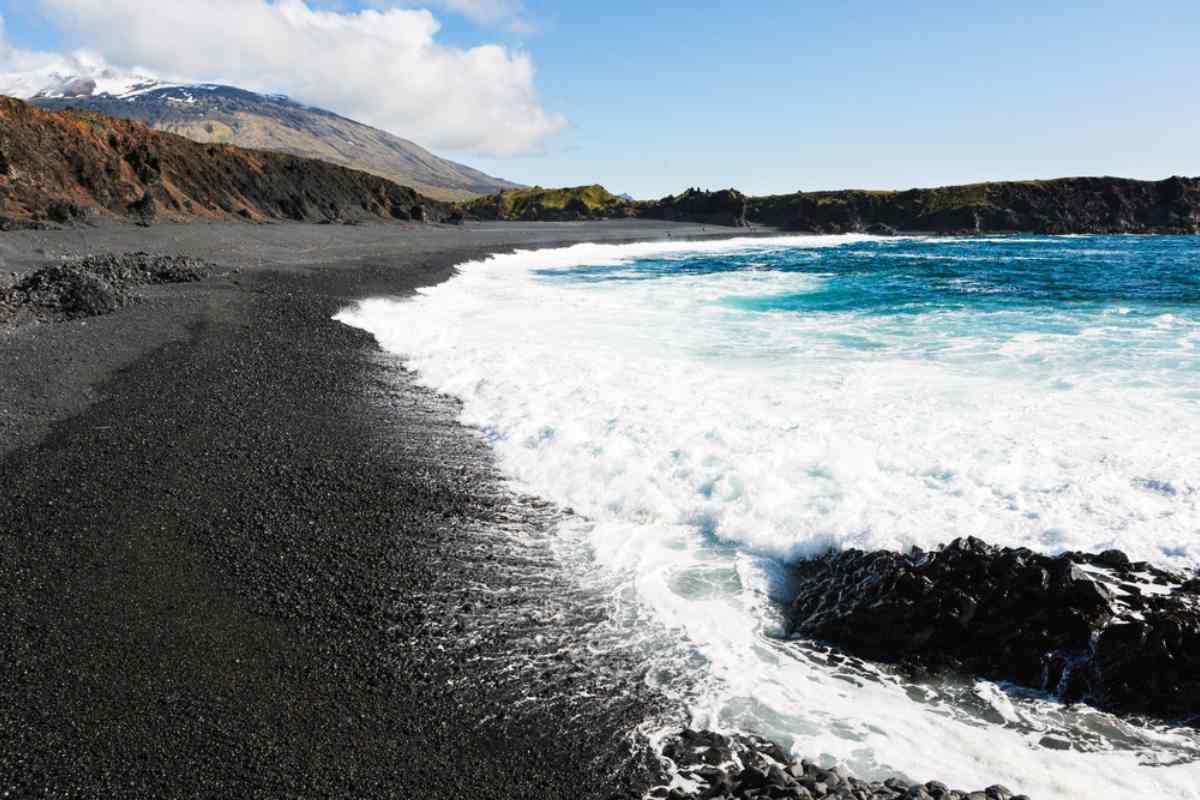
 By
By 
